How to Plan an Office Relocation
Here’s everything you need to know for a seamless and stress-free office move, with a comprehensive office move checklist
01
How to Plan an Office Relocation
Moving is a normal part of life, but that fact doesn’t make it any less stressful. It’s never an easy decision to make, but many businesses have to move to a new space at least once as their needs change. Whether you’re moving because of rapid growth, a better location or market reach, it’s too easy to get lost in the sea of paperwork and cardboard boxes that pile up during this process, all while you still have a business to run. To make your move a little simpler, use our office relocation project plan (and download it as a spreadsheet) to guide you through the entire process of moving an office, from planning to unpacking.
Getting Started
Long before you begin packing up, you should start assembling your relocation plan. In the early stages it doesn’t need to be completely concrete, but the details of your strategy should become clearer as the move draws nearer. Begin with the big picture stuff, including the general area in which you plan to settle, lease stipulations and employee needs.
Many businesses end up moving for ease of accessibility, so both your clients and employees need to be able to access your new location. Their satisfaction should be one of your top priorities. Understand your brand’s public perception as well as the feel of the neighborhoods you’re considering, assuring that it makes sense for you to relocate there. Draft your business development and expansion strategy with expansion in mind, noting new hires and space requirements that you might need over the next several years. Each company’s needs will be slightly different, so consider the ways in which your business will have to adapt to a new area and space.
After you have taken all of these factors into consideration, you should start looking for a reliable broker or business real estate agent to help you along in the process. On some occasions, you’ll be able to find a suitable office location on your own, but it can be quite a challenging and time consuming process. Moreover, some landlords work only with real estate brokers, limiting your options. Some businesses can rarely have a detailed look at a space for lease without a broker unless you are part of a large company or corporation.
You should also discuss the move with your stakeholders, including investors and employees, so you need a broker who is able to present multiple locations for consideration. Not all locations are created equal and not all of the available options will fit into your sometimes limited budget, so you will want to gather and pore over a varied list of possible office locations. Take your time and compare the advantages and disadvantages of each location. In the real world, there is no place that offers only advantages, no matter how perfect it might seem.
Space Options
Planning an office move is a critical business decision, so of course it shouldn’t be taken lightly. You’ll more than likely call your new office home for the next few years or decades, meaning that you should carefully consider your motivations and needs behind the relocation. More importantly, you need to know in great detail how the new office will address your pressing business needs. Assess all your current expenditures and compare them against the new office location. Take into consideration all the services you need to run your business smoothly and put them on the list to check how the new place compares to your current infrastructure. Nowadays, there are plenty of different ways to rent office space.
The traditional route is the classic leased building. Under this model, you will likely pay a monthly fee for your space, which will also often require a multi-year lease as well. You’re locked into this space for a while, so it’s crucial that it meets a majority of your needs. This option is stable and allows you to come to work each day in a space all your own, which is ideal for companies that want to stay in their new space for a long time.
A fresh option that’s especially viable for newer companies and startups is coworking, which allows you to rent a space inside of a larger facility that is shared between other companies, teams and freelancers. You likely won’t have to sign a lease, making it easy to cancel and relocate if you find a better space for your brand to grow. Coworking is especially popular among the younger crowd, allowing them to work side-by-side with other young professionals with different backgrounds and experience. However, you have to compromise on privacy at least a little bit. Only you can decide the right space for your relocation, so make sure you’re considering each option available to you, even the less obvious ones. You might be surprised at the location that ends up being the perfect fit.
Office Requirements
Now that you’re considering a variety of spaces, it’s time to get picky. Focus on tiny details that could become huge problems down the line. First and foremost, make sure that you can afford the rent, taking into consideration the fact that you’ll likely be signing a lease. Other obvious considerations should be if the landlord offers insurance, if the office can fit everyone comfortably and if it’s easily scalable for future growth. But there are plenty of other factors to include in your deliberations.
Look for a good number of conference rooms. Ensure that there is heating and cooling built into the space. Include amenities like a kitchen, communal spaces, multiple bathrooms, and even showers. Scour the immediate area for restaurants, shops, and cafés. Consider public transportation and parking. Make sure that clients and employees will feel safe and can find you easily. Count the number of power sockets. These details will make or break your new space.
Gearing Up
You should start getting a budget in place comprising of current figures and costs associated with your new location. Costs could be either lower or higher depending on the reason for the move, so it’s up to you to decide whether these expenditures are defendable from a financial standpoint. You’ll also need to plan also for relocation expenses and any bumps in the road that may come along. Moving costs include professional movers, shipping office furniture and losses due to downtime during the move. These are one-time expenditures, but they still impact your bottom line, so plan carefully.
Once you have selected your new place, you need to finalize your office relocation project plan to make the process as easy as possible. Before the moving trucks come, make sure you’ve finalized the lease for the new location and notified your current landlord of your move-out date. Advise your staff far in advance of the date and location of the move. Create a master list of everything, like mail services and bank accounts, that might be affected by moving, then send them moving notices. Bid and draft a contract with a moving company. You can also consider hiring an interior designer for the new office. Hold a meeting with everyone involved with the move at your new location at least three weeks in advance to ensure all details are covered and all responsibilities are clear.
Before the Move
It’s now time to get into the fine details. You should reserve elevators and loading docks for moving day and inventory everything you plan to bring along. A good rule of thumb is to plan to move any non-essential items first, then tackle bigger pieces. Another best practice is to label all boxes before the move. Audit your building keys and store them safely. Arrange for the storage or disposal of old files. Look into updated or new contracts for internet, utilities, office supplies, and other equipment like printers. Order updated stationery, business cards, and checks, plus any new office furniture or decor you might need. Make sure you’re listed in the new building directory.
On the employee side, there are plenty of other ways to prepare. Organize a staff moving committee if there is enough interest or need, then delegate responsibilities. Schedule and prepare an agenda for an employee moving meeting. Finalize a new seating plan or layout. Assign moving supervisors from each department who can look over more specific needs. Schedule post-move training for safety procedures. Distribute access cards and keys to your employees for easy access. Develop a master relocation project schedule, including packing, unpacking, stocking, and cleanup. You want to be operational as soon as possible after the move. Verify your moving insurance, set security procedures, and make sure you can access the new location. Arrange for your staff to tour new premises a few weeks prior to the move to get acquainted with the new space.
Moving Day
Thanks to all the planning before the big day, it might seem anticlimactic when it actually comes. Arrange with your building manager to have the air conditioning on during the move. Begin installing big equipment like servers as soon as possible. Keep an eye on your emergency contact list of experts for elevator maintenance, utilities, internet, and moving. Safety is your first and biggest priority. While the process is happening, make sure that you’re focusing both on big-picture stuff and smaller details, making sure that everyone knows their role and is contributing equally. Your employees should have the day off, and you’ll likely make the move over a weekend.
After the Move
Everything is inside and the movers have driven away. Now the harder work begins. Install and test your routers, computers, telephones and printers, making sure each works and troubleshooting as you go along. Devise and internally distribute a new phone list and office map, outlining the locations of departments, administrators and managers. Complete a detailed walkthrough of the premises, noting any issues or damages to report to the moving company or building owner. Audit the final invoice from the moving company against your contract.
You’re not entirely done with your old space yet. Confirm the termination of your old lease or agreement. Collect parking passes, security cards and keys for your old facility and ensure their return to the landlord. Transfer your insurance to your new location if you have not already done so, getting insurance certificates in the process. Complete and file all warranty information for all new furniture and equipment and update your fixed asset accounting system for all of those pieces as well. Confirm that your address has been correctly updated everywhere it needs to be. Schedule a press release and client announcement for the next business day.
Finishing Up
Moving can be one of the hardest yet most rewarding changes your business will face. After the move, make sure you take a moment to breathe and try to move beyond the stress of relocation. Give your teammates and employees the same treatment, especially if they have called the old location home for quite a while. Just like when you move houses, changing up your office space can be both exciting and hard to process at first.
In the first few days of operation, make an effort to be positive and to improve office culture. Your entire team has been through a lot, so make sure everyone feels appreciated. The relocation will be much easier if you lead by example and treat the new space as a beneficial and necessary step forward. Ask your employees what they want to see in the office and try to make it happen within your means. Make sure to create excitement, give regular updates, and involve your people throughout the whole process!
Key Takeaways
A business relocation plan is no easy job. It may involve dozens upon dozens of tasks and cover thousands of items, even in the case of a small business. However, the more thorough you are, the easier the move is likely to be. Laying the right groundwork is essential to success. When you’re considering a move or getting ready to relocate, make sure you do the following:
1. Draft a relocation plan including your desired area, your needs and wants, and how long you plan to stay.
2. Consider many different types of spaces for your new office, including ones you may never have decided to tour.
3. Create a tight budget and finalize your office relocation project plan weeks before your moving date.
4. Set yourself up for success by reserving elevators, setting up the internet and completing other small tasks before you start moving.
5. Install equipment and clean the new space as soon as possible to be able to reopen as soon as possible.
6. Treat the space like home and make sure to take a little time to relax.
Don’t forget about moving insurance, which is actually a must-have for many businesses. Cleaning up your last office location is another task you should have on your list. Really, any office move is a stressful experience, but if you equip your team with a comprehensive office move plan and have a thorough checklist in place, you can make the entire process more pleasant and efficient for everyone involved.
Download the Checklist for New Offices
Fill your space the right way with this supply list.
02
The Checklist for Your New Office
Whether you’re moving into your very first office or changing from one facility to another, most businesses will have to deal with the hassle of relocation at some point in their lifespans. Even the idea of moving can be stressful, but with the right planning, you can make the process a breeze. Setting up a new office can even act like an effective test of your business planning capacity, requiring you and your colleagues to mobilize your budget management, design and visualization skills to incorporate all of your essentials into one ideal workspace.
The new office setup checklist won’t work perfectly if you decide to leave it to chance. Solving sudden problems on the fly is an exception to this rule, but careful planning will only serve to make everything easier. Every office, from small spaces to startups to established offices, can benefit from planning ahead. Use this checklist to make the entire process — from choosing a security system to completing finishing touches — as easy as possible.
Picking a Location
While you may already have your ideal future location in mind, remain open to new possibilities until you sign your lease or ink a deal. You never know when the perfect space might come along. It’s suggested that you do your research and check out the area both online and in person. Look into safety concerns like crime rates and law enforcement, wellness factors like walkability and access to amenities, and business perks like proximity to clients.
Prioritize the health and safety of your employees — even if one location might be cheaper, consider the area as a whole before you commit to a lease. While picking your new location, don’t forget to consider other aspects of your business. Newer businesses could move into a coworking space instead of a traditional office building. Moving into an up-and-coming neighborhood could make your office look savvy and smart without much effort. Location, after all, is the reason why you’re planning to move. Make it count.
Managing Security
In the midst of the hectic moving process, many new managers forget that they need their new office to be a secure place. After all, moving is a perfect chance to install security measures with little downtime and relative ease. At the same time, consider internal security. For example, you need to decide between separate offices or divided desks. Most startups also share office space, so think about enacting security measures for an open, shared office, including locked cabinets and strong passwords.
The best way to accomplish total security in a modern office is with an access control system, which allows you to assign badges to all of your employees and monitor their access to certain amenities, including conference rooms and elevators, using card readers. If you are renting a space or just sharing a coworking office, you might not be in charge of the building’s access control, meaning that you need to seek approvals and permissions from the building manager. In contrast, you might be able to equip your rented or self-owned space with electronic access control and manage it all from your own central network. Choosing the right doors and locks, organizing alarms and detectors, and assigning proper access levels will help you serve the needs of your team while keeping your space safer. The good thing about modern security is that it’s incredibly smart, so you won’t have to worry about installing complex systems — in many cases, you can rely on a mobile app.
Optimizing Access Control
When managing security in your new office, you need to think ahead of any security issues, including burglary and natural disasters like fires. While they are worthwhile investments, nearly any camera or other alarm input can be deactivated, and a single locking mechanism can be broken if used as a standalone safety measure. In these cases, there is human factor that accounts for security breaches and information leaks. Access control systems allow workplaces to find an all-around solution to their safety needs, serving as an umbrella of multiple security devices that help to maintain safety within the premises. Access control also helps to protect valuable or sensitive assets and allows you to authenticate and authorize every cardholder and visitor who walks through your office. As an employer, this give your the power to identify your the appropriate level of access for each of your workers based on their role within an organization. For example, you can control when certain employees can enter the building and who has access to assets like laboratories or server rooms.
Legacy access control requires investment in servers, wires and in-house personnel who can supervise work on the system. As opposed to traditional physical access control systems, cloud-based access control is more cost-effective as it does not entail huge costs upfront, although owners of each space should seriously consider which type of system is right for them. Cloud-based is can be scaled easily and is more flexible, sparing you the hassle of hardwired components. Moreover, with IP access control, you can entrust your security to a service provider who will overlook all the processes all year round, so there’s no need to hire a security manager.
Choosing Equipment
After you’ve dealt with security, it’s time to think about the extra components of your office. Think workstations, internet, and furniture and decor. These are the basics for offices of any size, and they shouldn’t be chosen last-minute. Consider what, exactly, you’ll need for your space, both for business and for employee satisfaction. Make sure you have at least the basics in your kitchen, plus perks like vending machines and a dishwasher. You should have both private office space and communal areas for collaborative work. Furniture should be well-made and designed to work with your office’s layout and design style. Visualizing how a typical day or week at work would look like is a helpful exercise to use when deciding how to fill your space with equipment.
One of the most important resources to immediately check off of your office setup plan is setting up your internet connection. Establishing internet is the easiest way to get your workspace back online without too much interruption. Necessary physical technology most often includes phones, a fax machine, copiers, shredders, projectors, computers and servers. If you’re working with a limited budget, you should only include the essentials and avoid investing in larger equipment. It might be wiser, for example, to outsource printing, copying or faxing services to an external provider. To save money, especially in coworking spaces, you can try a bring-your-own-device (BYOD) policy. You should also invest in software such as anti-viruses as well as various applications needed to run your business. Office supplies like stationery and pens should also be stocked before you open your doors.
Sample Checklist for Small Offices
The small office set up plan is a challenging task, but with a bit more attention to detail, you can turn your new space into a functional and pleasant workplace. Pay attention to these details:
- Decide whether to rent or lease equipment and services to save money and space.
- Design a smart office layout, including steps like placing team members as neighbors and providing equal access to certain communal amenities like files and the kitchen.
- Maximize the potential of the floor plan by examining each separate areas. Include a small reception desk instead an entire area, meeting tables instead of conference rooms and kitchen space that can possibly replace a conference room when there are no free ones.
- Remove unwieldy furniture and unnecessary IT equipment that will only take up extra space and make planning harder. Really think this part through — it can impact your office for years to come.
- Maintain safety and security standards by thinking about these needs in new ways. Choose ergonomic furniture, proper internal and external lighting, private workstations, fire extinguishers and a smart access control system.
- Don’t forget about interior design choices. Make sure you have a consistent style throughout your space, which will be better for both your employees and visitors.
- If your office is animal-friendly, think of how this policy might affect the daily work of your employees in such a small space.
- You can cut down a long list for a small office set up by paying attention to what you can do by yourself and what is best left to others.
Sample Checklist for Startups
A startup office needs to be able to respond to rapidly changing needs. Launching a new business in a real office comes with plenty of risks, mostly due to space and budget constraints. Pay attention to these details:
- Understand if you own or lease your workspace. Be wary about signing a multi-year lease, especially if you anticipate rapid growth.
- Consider coworking, which is good for startups that want a formal space, but don’t need a great deal of room.
- Think ahead about working from home and if this will mean you will implement a BYOD policy. Requiring your employees to provide their own device can reduce costs and make remote working much easier.
- Look into what, if any, alterations can be made to the decor and design of your rented space.
- Decide if you plan to work with your building’s wireless network or if you plan to install your own servers, which can increase internet speed, security, and fidelity.
- Plan ahead for security, including how you might implement an access control system if you do not already have one installed in the building. Security is incredibly important for startups, which often deal with sensitive information or plans.
- Budget for high-quality furniture, office supplies and stationery. Purchase only what is necessary and rely on renting for pieces that you cannot yet afford or can easily be unloaded on an outside contractor. Vendors should be arranged for everything from staples to snacks to copiers.
- Make sure your space is ready for visitors. If you plan to bring investors or members of the media inside, their experience will be crucial in how they view your business, so make sure you have solid, modern interior design.
Sample Checklist for Large Offices
Whether you’re part of an established corporation or a small office making the jump to a big one, moving into bigger spaces presents its own set of challenges. There are many departments and even more people in large firms, which means that space should be organized smartly and efficiently. Pay attention to these details:
- Decide whether to use separate areas for each department or to opt for a more centralized layout. Security, sociability and ease of use should all factor into this major decision.
- Make sure there is easily accessible parking or transportation resources within your building’s vicinity.
- When it comes to choosing between open space and private offices, spend time thinking about what suits your business model more. Thankfully, it’s not black and white — you can do entirely one or the other, but you can also choose to place an emphasis on both styles of working, which might make your office feel more social.
- Create meeting rooms for customers and partners, which can also double as conference rooms. Pay attention to the technology and design details within these spaces, which can make your business look even more professional.
- Designate common areas where employees can interact. There are the typical spaces such as kitchens and conference rooms, but you can also install a lounge with comfortable seats and plenty of table space for a place to work away from a desk.
- Implement an access control system and decide how it can be implemented based on the setup of the office. The more complex your layout or hierarchy is within your organization, the more layered the access to assets and information will have to be. However, even complex offices can be given access control without much difficulty.
Taking the Next Step
Although moving into a new space can be stressful under even the most ideal circumstances, the benefits of a move often outweigh the drawbacks. Small businesses and startups can benefit from the professionalism and legitimacy that an office space provides. Larger offices, meanwhile, can completely reinvent the boring layouts that are favored by tradition, but not by employees.
Finally deciding to move from your current space to a new one is a tough decision that ensures more work on your end, but planning ahead properly will only make the undesirable parts of this process easier and less stressful. Before you move, make sure that you’re relocating to the best possible space, that you are sticking to a reliable budget, that you have a plan for when you arrive, and that you are ready to reopen as soon as possible. With a proper checklist, moving is no longer a hassle — it can be a positive experience.
Download the Office Cleaning Checklist
Our chat with Managed by Q, summarized in one downloadable list.
03
Top Modern Startup Offices
10 Modern Startup Offices You Have to See to Believe
These startups are not only taking the New York and the U.S by storm, their startup offices are making a splash in the design world. Whoever said cubicles and white walls are elements of great design could not have been more wrong. It takes creativity, ingenuity and great taste to make any space modern and great. Not only are these startups revolutionizing their particular industries, they are also taking their office design and decor to the next level.
Intent Media

This relatively young company took New York by storm in 2009 and has become a leader in retail media and commerce advertising. What is special about their office is the open concept design. Their minimalist design and attention to industrial details makes this space truly unique.
The Farm
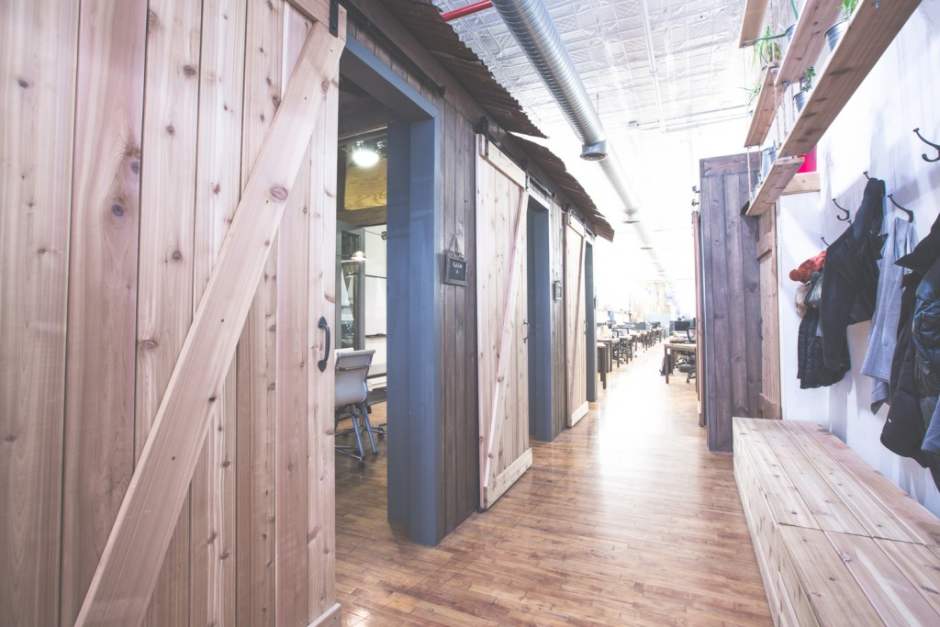
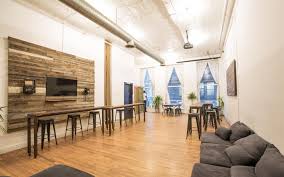

As its name indicates, The Farm is a rustic oasis in NYC. This co working space truly stands out thanks to its thematic accents. The barn inspired doors, and wood furniture give this space a rustic feel. If you want to leave the city without stepping outside of Manhattan, this is the place to go.
StyleSeat

Styleseat makes looking your best easy and effortless. Their mission is to make beauty experts accessible with a click of a button. Their focus on beauty greatly translates into their San Francisco office. Open space is beautified by wood beams and a slick glass balcony. The office is also decorated with plants and wood beams to create a warm and natural feel.
Awesome
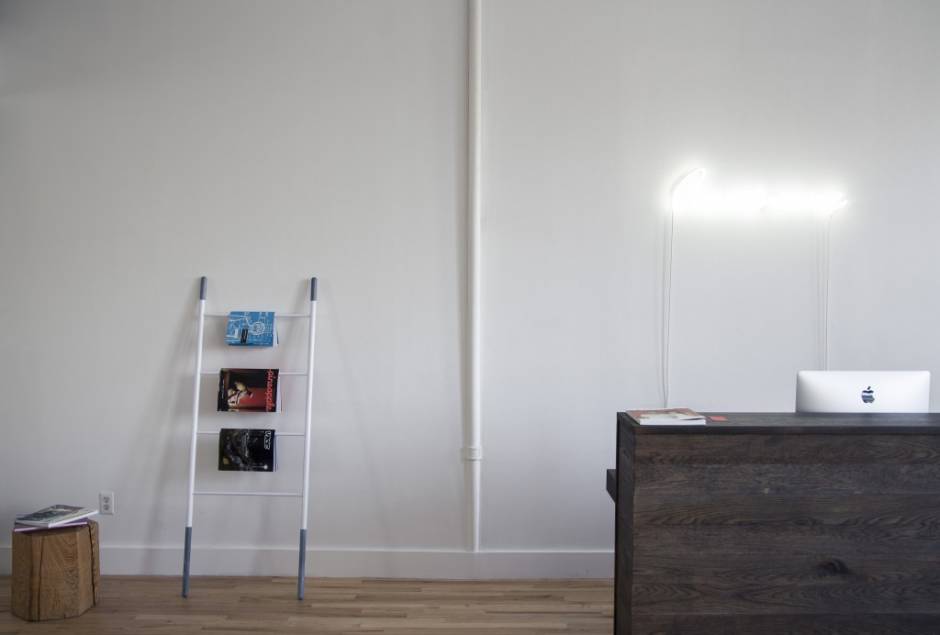
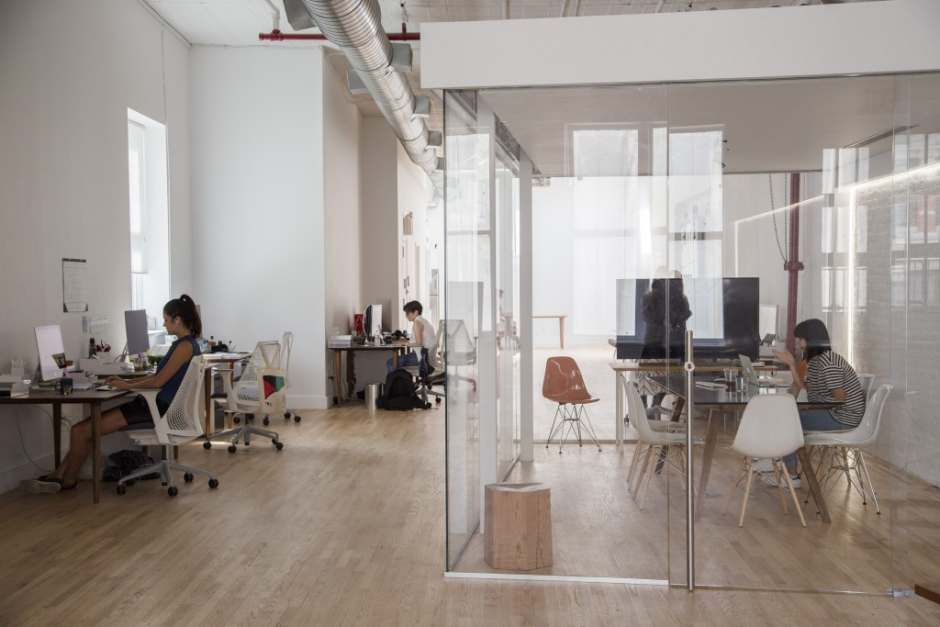

Awesome is among the top design agencies in NYC. This great space features modern glass offices, minimalist furniture, high ceilings, and industrial elements. Its emphasis on minimalism and attention to architectural design and human centric technology makes the office truly beautiful and an eye-pleaser.
Kargo
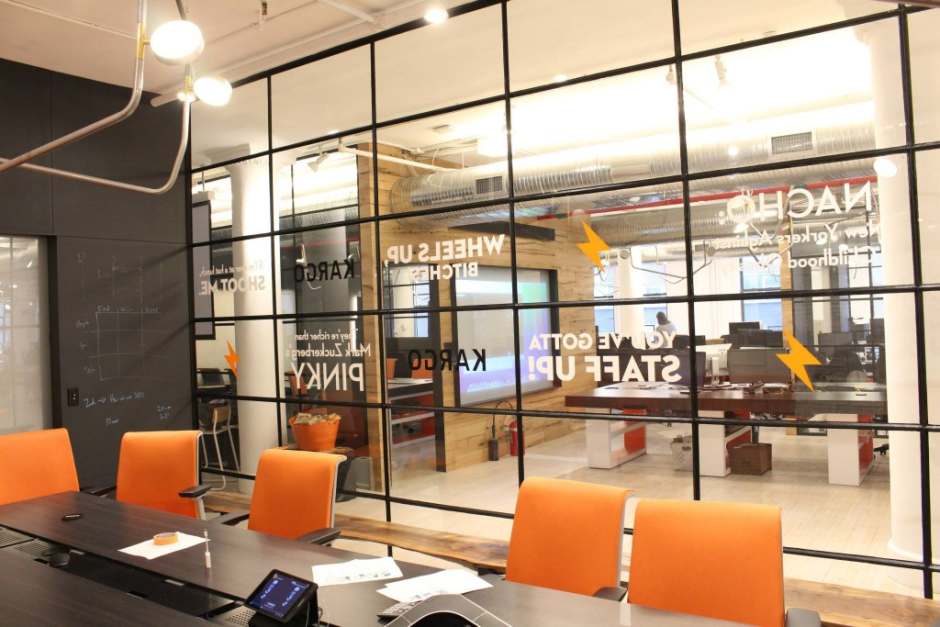
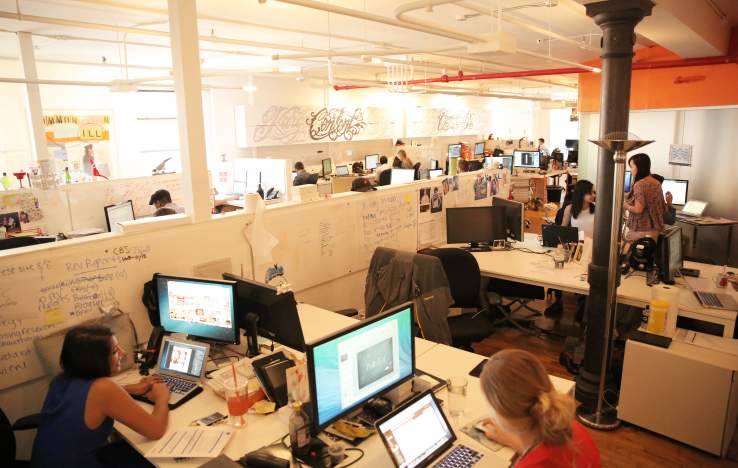
Kargo’s combines seamless experiences with brand advertising to create one of the best marketing platforms. Their focus on interactive user experiences translate into their startup office design. The strategic use of orange in different parts of the office matches their logo and their website’s color scheme.
Bark & Co
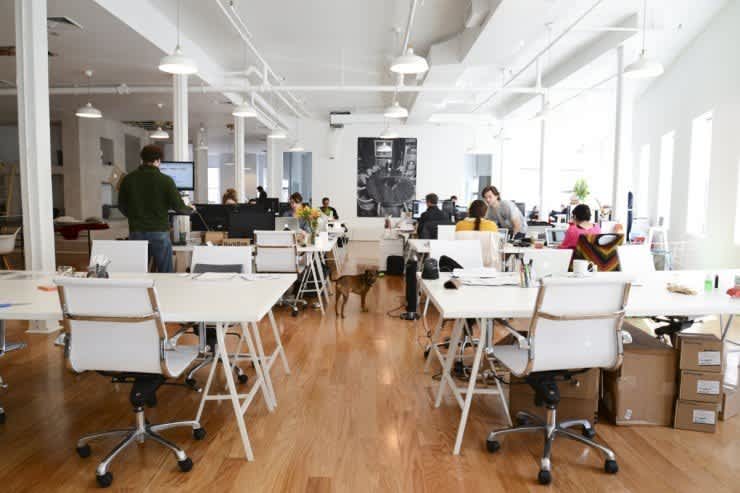
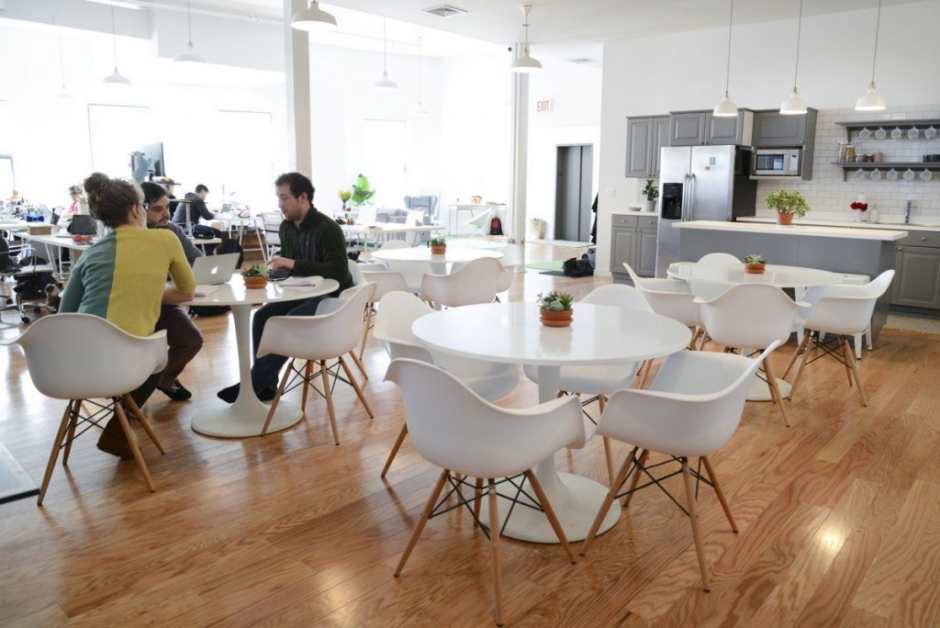
Bark & Co’s love for dogs goes beyond providing them with treats, and dog-friendly vibe translates in their relaxed and friendly office atmosphere. Their white furniture along with gray and red accents exudes a contemporary atmosphere. Plus the spacious kitchen and open layout makes it a great startup office to work.
Skycatch

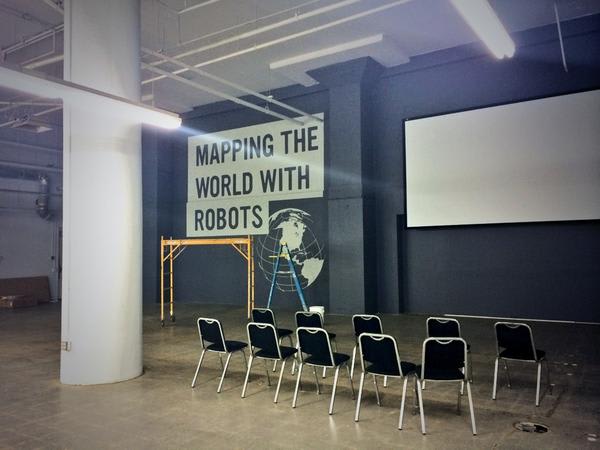
In the span of 2 years, Skycatch has become a leader in drones and robotics. Aside from dominating one of the most innovative and forward thinking industries, this company also dominates in office design. One of the most distinctive aspects of its office is its pops of color. Unlike other startup offices whose main color scheme are neutrals, Skycatch truly takes advantage of vivid colors such as yellow, green, and blue to brighten the office and its co-workers.
Harry’s
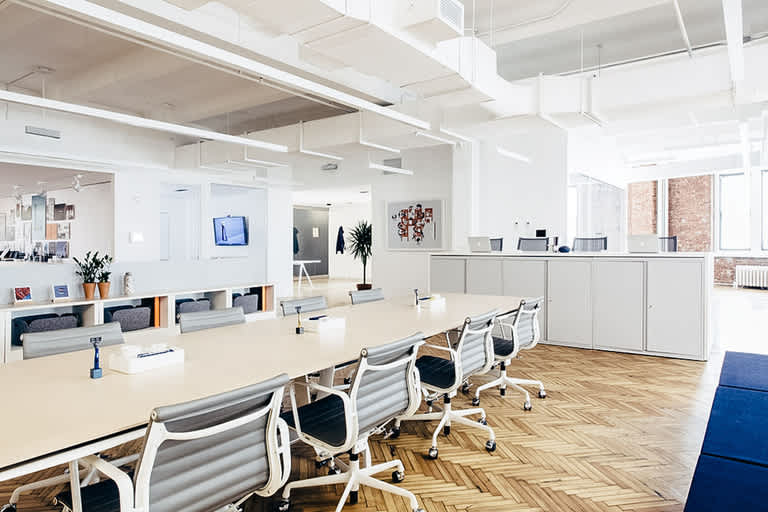
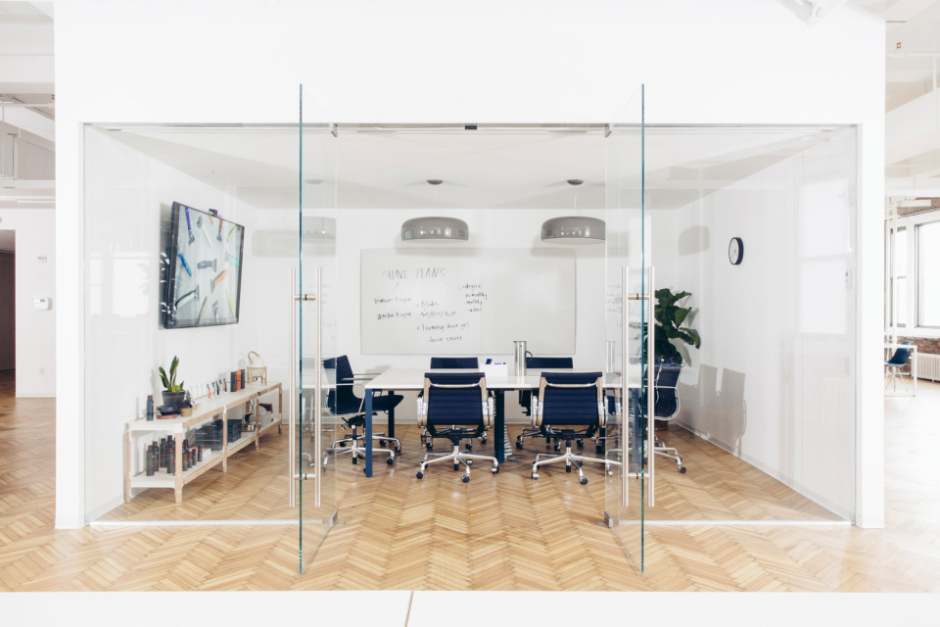

Harry’s is a delivery service selling top of the line razors. With only a few years in the market, this newcomer is disrupting a 30 billion dollar industry. And guess what? Their office is also creating some buzz in the interior design industry. I mean, how can you not want to work at their beautifully renovated Soho loft, where their office features repurposed brick walls, high ceilings glass wall, and modern furniture.
Download the Basics of Office Security
Professional insights on how to secure your workplace.
04
Tips for a Trouble-Free Transition
Planning an office move is both exciting and stressful—and if you’re an office manager, it’s probably more stressful for you than almost anyone else. Whatever your company’s reason for moving (whether it’s to relocate to a more convenient locale, or to scale the org up or down), the task won’t be a small one. And the breadth of factors to consider can become even more staggering when you’re constrained by a tight budget and/or a time crunch. Luckily, we have a few tips that’ll make your move as frictionless as possible.
Get the Timing Right
Having a sizeable buffer of time before the big move is the key to making the transition less of a hassle. Unless you’re moving into a turnkey, pre-furnished space, you’ll want to start the moving process four to six months before your projected move-in date. We recommend that you pick a convenient time six months in advance—a good rule of thumb is to choose a 2-3-week period in which there are no big client or board meetings and no important deadlines. Check in with stakeholders from each team to find a window of time that everyone can comfortably plan around.
Pick the Right Moving Company
Because there’s so much more that goes into relocating a business than a residence, you’ll want to err on the earlier side when it comes to hiring movers. Aim to hire one to three months in advance, depending on the scale of your move.
Before contacting movers, determine your budget and the type of moving services your business will need. If convenience is king, you may want to look into experienced full-service movers who will take care of everything for you, including packing and unpacking. SMBs in expensive markets like New York City, where office space can cost up to $80/square foot, might prioritize being economical and prefer to get as much done in-house as possible. For this, consider project-based office relocation services.
Once you hire movers, you’ll want to provide them with detailed layouts and floor plans of both your current and your new office as soon as possible. And because you’re better off safe than sorry, take the necessary precautions: Request the movers’ insurance information in advance, and ensure that the floor and walls will be protected to avoid damage during moving.
Communication is Key
The move should interfere with productivity as little as possible, so you’ll want to let employees know about it well in advance. Communicate all crucial details of the move to everyone at the company, so they can take the necessary steps at their leisure.
You should also involve IT team members when touring viable office spaces, as they’ll need to assess the new space and make sure that all the right infrastructure is in place to accommodate your business’s technology. You don’t want to be locked into a lease when you realize that a space isn’t right for your company’s tech needs.
Optimize for organization
A big move presents a great opportunity to do a little spring cleaning. When packing up the office, throw away any old materials that are no longer necessary—when unpacking, your future self will thank you. Ditching the nonessentials will make you more efficient, thereby making it easier to stay organized.
Other organizational tips include labelling or color-coding all your boxes, so that you aren’t stuck trying to remember what goes where in the new space. Employees can write their names on their boxes for movers to match to a seating chart and place in the correct spot—this will help avoid a frenzy of people looking for their belongings.
Get up-to-Date
You’ll want to get in front of updating your address information well before relocation, so that you’re not getting mail or clients showing up to your old address. Update your Google business listing at least three weeks in advance; if you’re not eligible to verify changes by phone or email, you’ll need to verify by mail, which can take up to two weeks (and we always recommend building a buffer for those just-in-case situations!) Make sure that any other directories, in which your business is listed, get updated as well and that all clients are notified. Additionally, as soon as your lease terms are squared away, start updating your printed materials—business cards, sales collateral, and anything else with the company address on it.
Above all, make sure you’re giving yourself enough time to prepare for any unexpected considerations that may arise, and that you’re communicating with stakeholders along the way. Though this process may feel overwhelming, our tips above will set you up for a stress-free move.
SquareFoot is a commercial real estate technology firm dedicated to finding the perfect office space for businesses as they evolve. Based in New York City, SquareFoot uses smart tools to aggregate listings throughout the U.S. and Canada.
The Ultimate Guide to Office Operations
Featuring expert advice from office managers & tech specialists.
05
Office Manager During a Move
When companies have outgrown their space and take on an office relocation project, it is common to hire a project manager. But when the move is complete, who is left to take on daily office operations? Who coordinates with building security and schedules office cleaning services? What about planning weekly happy hours? Catering daily lunches?
Keeping the office running smoothly during a period of rapid growth is no easy task; having a dedicated office manager to ensure the coordination and preservation of your company’s culture, technology, and security is crucial.
Marcie Kowalski, Head of Global Facilities and Real Estate of Turing Pharmaceuticals LLC, is a distinguished professional with years of experience in facility and operations management. She has vast knowledge of what it takes to grow companies in everything from real estate and property management, to company culture and technology processes.
Currently, Kowalski is in charge of finding locations, hiring staff, and building out policies and procedures for her rapidly expanding organization. According to Kowalski, owning such an important part of the business includes “negotiating deals with real estate brokers, project managers, architects, construction managers, and engineering firms.”
Although this may seem like a lot for one individual to take on, Kowalski doesn’t believe in outsourcing project managers or office managers, as it isn’t an accurate reflection of the culture the company is looking to foster. Having someone who “lives and breathes the culture every single day,” is critical to growing and integrating the company culture into every aspect of the business, Kowalski says.
It’s safe to say that Kowalski is an office management rockstar. She’s the heartbeat of the company: she is constantly working both behind and in front of the scenes to ensure her company is running smoothly. She’s a champion of the office culture, a promoter of a positive work environment, and an advocate for great technology.
With the help and insights from Kowalski, we’ve put together 3 tips for office managers who are looking to be a company rockstar.
Tip 1: Be Adaptable and Agile
At a growing startup, change is inevitable; you’re constantly hiring, moving offices, adjusting your culture, adopting new technologies, and so much more. Owning such a large part of the ever-changing atmosphere at a company requires office managers to be able to easily adapt to new situations and be agile in their task management. There’s no doubt it’s a lot for one person to own, so being organized and having good critical thinking skills is imperative.
Your agility as an office manager is crucial to ensuring the success of the company. Your role involves so many areas of the business – operations, facilities, human resources, IT, culture – so being able to quickly pivot from a task in one area of the business to the next will allow you to tackle and own overall growth of the company.
To guarantee this success, no office manager is complete without his or her technology toolkit. For project management, Kowalski suggests Wunderlist, an app that allows you to “get stuff done” by managing your to-do lists, reminders, and errands. For visitor management, Envoy is a powerful and easy-to-use tool. Slack is a widely-used communication tool that gives office managers the ability to monitor company channels and send out updates on the company, team, or individual levels.
The key to selecting the right tools for your company is to understand the needs of your company; office management tools are not a one size fits all solution. Once you’ve established this, your use of the tools you select allows you to adapt to and complete your tasks quickly, efficiently, and seamlessly.
Tip 2: Talk to and Communicate With Co-Workers Everyday
In a startup environment where everyone is scrambling to accomplish as much as possible as quickly as possible (especially office managers), maintaining strong communication between teams can easily fall by the wayside.
Everyone from interns to managers to the CEO should be part of your communication strategy with the company, as they are all dependent on you whether they realize it or not. While you may not need to update everyone in the company on a daily basis, you should at the very least be keeping the company in the loop by letting them know of changes you are implementing that will impact their day-to-day work experience. By communicating with employees, you’re establishing expectations with your peers and ensuring that they’re never caught off-guard by changes.
Outside of communicating your efforts with the company, you should be in contact with teams within the organization that you can leverage or work alongside to streamline your efforts.
For example, IT managers and office managers are often thought to have two completely different roles when, in fact, they have many of the same job responsibilities such as office security and access management.
“It is not uncommon for an office manager to do what the IT manager does, so it’s important for them to work and communicate closely as the company grows,” says Kowalski.
Because facilities are often an organization’s largest expense that falls under the non-revenue generation category, Kowalski stressed that it’s critical to have a direct line of communication with the COO and CFO to set proper expectations. As an office manager, you are in charge of emphasizing why daily operating costs are needed and how they correlate to company growth.
Tip 3: The Office Manager’s ABCs – Always Be Considering
At the end of the day, office and facility management demands a lot from managers. When you’re asking one individual to take on such a variety of duties – from reordering office supplies to installing a new security system, to choosing a new office space, to letting the company know that lunch is being served – it’s easy to feel stretched thin and short of creativity.
To tackle this, Kowalski follows the ABC principle: “Always Be Considering.” For her, everything is an opportunity to spark a new idea for tackling her job in a fun, creative way. “I can go to Starbucks, be staying at a hotel, or be reading a magazine, and something may catch my eye and trigger inspiration. I’ll think ‘Wow, I can apply this to my office.’”
Not only is Kowalski always learning from her day-to-day role at her company, she’s following the ABCs to optimize the impact she has.
When Kowalski has time to do some proactive learning about office management, however, her favorite reads are:
Being an office manager is an ever-changing role, especially in the startup environment. You have hundreds – if not thousands – of job duties, many of them invisible to the average employee. During an office move, your responsibilities are multiplied and the impact of your actions are magnified. By remaining adaptable and agile, open to communication, and mindful of the inspiration around you, you’ll establish yourself as the badass office manager who’s running the show.
Download the Checklist for New Offices
Fill your space the right way with this supply list.
06
Interior Design for Office Moves
Thomas Jensen’s clean office interior aesthetics, with his emphasis on open windows, airy, shared workspaces, and shafts of light, define JIDK’s approach and the firm’s goal of creating “happy and bright offices that are healthy for people to work in.” Jensen has been working with the restrictions of NYC real estate landscape, since 2008, to help improve the offices of major tech companies and entertainment startups. As a middle man and communicator, Jensen is concerned with ensuring smooth office relocation process for his clients.

On a personal level, my daily responsibilities involve communicating decisions and needs. At JIDK, I am the middle person between specialists and clients where I communicate the needs of the clients and translate these needs or requests into actionable plans and details for the specialists – architects, interior designers.
He discussed the disconnect in information that affects the stakeholders during the moving office process. Jensen also shared the tips and lessons he has gained from his experience in commercial office design.
Understanding The Office Relocation Process From The Perspective Of An Interior Design Service
Office relocation typically takes about 6 months from start to finish. There is usually 2-3 months of preparation meetings, design, lease negotiation and permit filing before any construction begins. Depending on the size of the project and the condition of the site, construction usually takes about the same amount of time. After the client moves in, JIDK likes to spend about a month conducting follow ups and tweaking the site to make sure the client is satisfied.
When the client first signs on, Thomas sits down to discuss their brand identity and vision for the new space. “We meet our clients first to get to know their values and needs better. They have a good story to tell and these narratives often serves as a good inspiration fodder for us.”
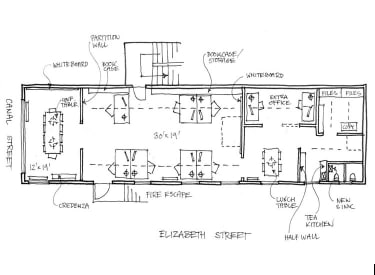
At their earlier stages, Buzzfeed positioned itself as an undercover detective agency, investigating and scooping on good stories and news. In response, Jensen was inspired by Kar Wai Wong’s 1950s cinematic renditions of Hong Kong offices , seen in the The Mood For Love.
The design philosophy of JIDK is simple. They take a fluid and organic design approach, which manifests in Jensen’s personal vision of an office.
Personally, I believe the office is part of a fluid lifestyle. It is not static but evolving where the office is multi functional in its needs, accommodating organically to its people lifestyle
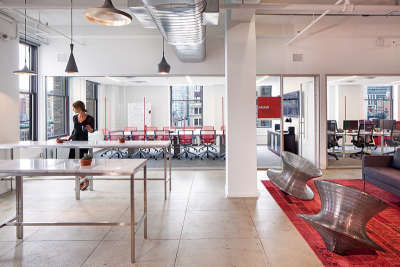
For more tips on coworking space design, do not forget to check out our article.
How Not To Work And Why It Affects The Office Moving Process
Clients often wrongly perceive an office relocation project as a home relocation project.
“Planning an interior design strategy for an office differs from planning an interior design for a home.” He said that with moving and planning a design for a new office, there are often various factors and considerations that come into such planning. The company’s working style. The office layout. The test fit drawing of the physical office. The identity the company wants to portray to the visitors. “To believe that the process of planning for an office is synonymous to the process of planning for a house would be problematic.”
Enterprise technologies and design are unlike home technologies and design. It requires more planning and researching where it helps to incorporate new technologies early in your office design strategy. As with design and new technologies, incorporating IT and office interior design later in the process is often tricky and complicated. “Technology is often seen as an accessory but it is a tool that should be planned early on in the design process.”
Getting an expert to facilitate with office moving, too late in the process.
One area where clients often mistake: they try to research the office moving process alone, without the help of experts. The time taken to research the office relocation, in-depth knowledge and technical literature of each individual process – leasing, brokerage, architecture consulting to interior design – could otherwise have been more efficiently used for everyday business operations.
When you get an expert as soon as possible, it really helps to ease the workload and pressures of moving an office.
How To Work And Why It Matters For Your Moving Office
The ideal client is self aware of its corporate identity and new office space.
In Jensen’s experience, an ideal client would have a new office space “with great light and empty to space to work from. They would also have a strong identity of their firm, where they would know what they want.”

Looking at a test-fit plan is crucial to understanding your new space. As with the nature of the human eye, “there is human error when it comes to visualizing and judging an empty space so a test fit space plan is important for any interior architectural team to ascertain the amount of square footage of an office space.” Most often what happened without proper test fit of an office is: a client walks into the space thinking that they can fit a certain number of desks. The reality is they often overestimate – or underestimate – the potential of their office space.
Client knows what they want and is transparent about their office relocation process and information.
“When it comes to renovating an office, it is crucial to be transparent about the process to both the stakeholders – brokers and interior design consultants. Clients should check with brokers on renovation restrictions of their office space.“ He mused and insightfully added, “It is a matter of managing expectations of the different players.”
Parting Thoughts
Jensen ended with five tips to ensure a smooth office relocation.
- Bring in experts early in the process.
- Assign a project manager to be in charge of the office relocation.
- Be realistic and transparent with the landlord and broker. Whatever your budget is, be transparent about it.
- Use test fit and visualization.
- Incorporate technology early in your plan.
Enable cookies to help us improve your experience.
We use cookies to enchance your experience and for marketing purposes. By clicking ‘accept’, you agree to this use.